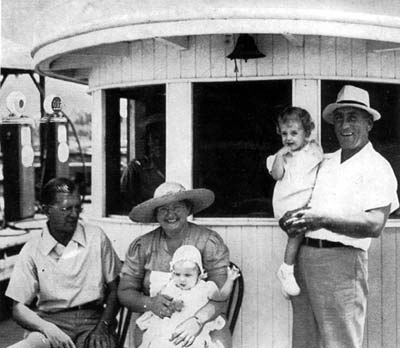
Croats in Louisiana andMississippi
A Centuries’ Long Story
By John Peter Kraljic
In 1880, Miho Baccich landed in New Orleans. The Korcula nativewho had sailed the seven seas and survived a dramatic shipwreck off ofAustralia, had recently received command of his first ship, the Resurrection,owned by his uncle, Nikola. Baccich was surprised by New Orleans. "Howironic that in my first glimpse of America, where I expected to find Americansor men of English origin, I found a very European city with a variety ofEuropeans. During the next week, I was to discover many attractive features ofthis exiting place. First, it was so large and dynamic - over 200,000 residents!The Croatian colony was also large, nearly a thousand people, and [I was]introduced to many of them. A large number were already owners of their ownsmall businesses, retail stores, restaurants and oyster fisheries (a favoritebusiness among Dalmatians)." Baccich said that for four days he socialized"with the local Croatians and I saw a camaraderie that I had never knownbefore." He made up his mind: - Baccich stayed in New Orleans, married alocal Croatian woman and became a successful businessman. His efforts wererewarded by the naming of a city street after him in the city (the street runsparallel to the Inner Harbor Navigation Channel).
Baccich came upon one of the first Croatian colonies to beestablished in the United States. The first Croats to settle in Louisianaconsisted of men like Baccich, sailors from Dubrovnik, Orebić, Bokakotarska and their surroundings who traded in the French colony in the 1700s.
By the 1840s, dozens of Croats had stores and otherestablishments in New Orleans. During the 1850s, a "second generation"of Croatian immigrants came to New Orleans. Led by Luka Jurišić from Dubaon Pelješac, they began to cultivate the oyster trade, establishing what becameone of Louisiana’s largest industries. Later, many went into the shrimpingbusiness as well. Louisiana’s Croatian fishermen and oystermen continue to beespecially concentrated in Plaquemines Parish, especially in the towns ofEmpire, Olga, Buras, Ostrica, Venice and Port Sulphur.
In the 1860s, Louisiana’s Croats fought for the South in theAmerican Civil War, establishing at least three companies (the First and SecondSlavonian Rifles and the Cognevich Company) and fighting in many others.
On May 1, 1874, the Croats of New Orleans established the secondCroatian organization in the United States, the United Slavonian BenevolentAssociation (Sjedinjeno Slovinkso Društvo Dobročinstva). TheAssociation numbered 200 members in the mid-1970s, even though its bylaws onlyallowed men born in the territory of former Yugoslavia and their direct maledescendents to be members! The Association (renamed as the United CroatianBenevolent Association) had 152 members in 1996 and still served the Croatiancommunity.
New Orleanian Croats became especially well-known asrestaurateurs. A list from the late 1930s listed 17 restaurants and 3 tavernsowned by Croats (including the famous Uglesich’s which was featured in TheNew York Times earlier this year as it was set to close its doors). NewOrleans Croatian cooking continues to this day, the restaurants including Drago’s,opened in 1970 by Drago and Klara Civtanović. Another legendary restaurantfrom the 1930s includes the Broad Inn Restaurant, owned by Chris Matulic,which later grew into Chris’ Steakhouse, the ancestor of the nownationally known chain as Ruth’s Chris Steakhouse.
The arrival of Croats in Biloxi, Mississippi is also tied to theoyster industry which began in that city around 1880. As in Plaquemines Parish,Croats dominated the oyster and shrimp trade in Biloxi as well. The Croats inBiloxi also became very active socially, having a CFU lodge as early as the1930s. The Croats had their own hall, Slavonian Hall, which unfortunatelyappears to have been destroyed by Hurricane Katrina (one unusual fact - ElvisPresley performed at the Hall in 1955 during the dedication of the Hall’s newair conditioning system!).
The recent hurricanes which devastated New Orleans, Biloxi andother towns are not the first to cause havoc to Croat settlers in the region. Astorm in 1893 destroyed a small town of Croats near New Orleans. The stormkilled 252 of the town’s 400 people.
Other storms killed off another agricultural project promoted byCroats, the growing of oranges and the making of orange wine in Triumph,Louisiana. This business had been especially spearheaded by settlers from Igraneand Podgora near Makarska.
The hurricane which has until now been most remembered by theCroatian communities in the South was Hurricane Camille in 1969. Camille hitBiloxi especially hard and, among others, destroyed Baricev’s SeafoodRestaurant (a recent mystery novel, Green-Eyed Hurricane, by MartinHegwood, features as its victim Biloxi shrimper Casper "Cass"Perinovich, a Croatian whose wife and son had been killed by Camille).
That Katrina is but one of many storms to have hit ourcommunities in the Gulf gives little comfort to those in need today. However, ifthe past is an indicator of the future, one has great hope that the Croatianpeople of the region will rebuild their lives and continue their outstandingcontributions to their cities, towns and villages.

Croatian family of Joe Buccaran (right) pictured in 1940
with wife and daughters Barbara and Ann.
Photo courtesy of Fedora Rukanic from New York.